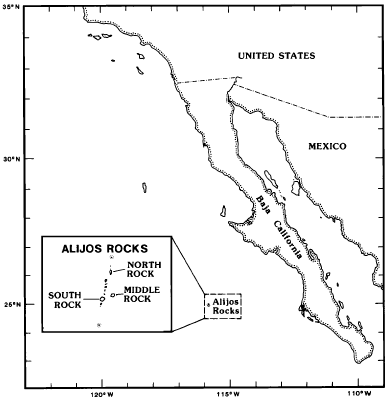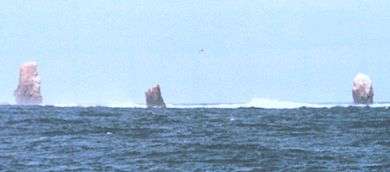Rocas Alijos
Rocas Alijos, or Escollos Alijos (English: Alijos Rocks) are a group of tiny, steep and barren volcanic islets or above-water (as well as below-water) rocks in the Pacific Ocean at 24°57′31″N 115°44′59″W. They are part of Comondú municipality of the Mexican state of Baja California Sur, and situated about 300 km west of the mainland. The total surface area is less than 1,000 square metres. The official area figure of 0.012 square kilometres (0.0046 sq mi).[1]



The group consists of three principal rocks and numerous smaller ones. South Rock, the largest of the group, is 34 meters (111 ft) high, with a diameter of only 14 meters (46 ft) (position 24°57′03″N 115°44′55″W). Middle Rock is 18 meters (59 ft) high and about 10 meters (33 ft) in diameter. North Rock, 200 meters (656 ft) north of South Rock, is 22 meters (72 ft) high, with a diameter of 12 meters (39 ft). The rocks in between those are either submerged or so low that they are barely visible among the heavily breaking waves.
The rocks seem to be known since the early Spanish history of Mexico; they can be found on a map from 1598. The first description is from 1704, by pirate John Clipperton. But only in 1791 the first exact description was made by a Spanish sailor. South Rock was climbed for the first time in 1990 by an expedition (October 31 through November 7, 1990) under the leadership of Robert Schmieder, who edited a monograph about the rocks.[2]
The group is located at the transition zone between two major biologic provinces, at a latitude where the Pacific Current turns westward to form the North Pacific trans-oceanic current. The rocks are nesting sites of many seabirds.
The two other Mexican island groups in the Pacific Ocean that are not on the continental shelf are Guadalupe Island and Revillagigedo Islands.
Fauna
The breeding marine avifauna of Alijos Rocks currently consists of Leach's storm-petrel (a presumed breeder, probably a few pairs), red-billed tropicbird (14 birds), masked booby (100), and sooty tern (250). The magnificent frigatebird is a regular winter visitor but probably does not breed. The Laysan albatross is currently an annual visitor to Alijos Rocks during its winter breeding season, and may start to nest there in the near future.
References
- Archived July 11, 2007, at the Wayback Machine
- Archived May 24, 2011, at the Wayback Machine
External links
- Radio enthusiast's description
- more detailed description in German
- sailing directions
- Rocas Alijos: Scientific Results from the Cordell Expeditions
- The Marine Birds of Alijos Rocks, Mexico
- Cordell Expeditions Homepage
- Rocas Alijos part of Comondú municipality
- Video: Tuna fishing beginning at Alijos Rocks, October 2005
Literature
- Robert W. Schmieder, Ed.: Rocas Alijos: Scientific Results from the Cordell Expeditions, Dordrecht; Boston: Kluwer Academic Publishers, 1996, ISBN 0-7923-4056-6 (Series: Monographiae biologicae, v. 75)